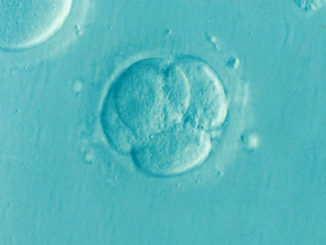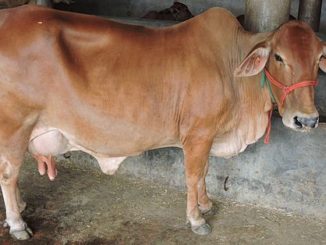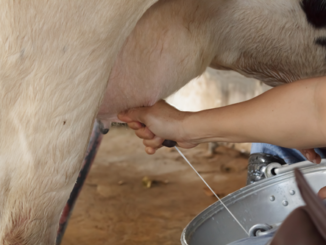1. Puerperal endometritis
It is an acute systemic illness due to infection of the uterus with bacteria mostly within 10 days after parturition. It is often associated with RFM dystocia, still birth or twins and mostly occurs toward the end of the first week postpartum.
Diagnosis
It is based on clinical sign’s (fetid red brown watery discharge, fever >39.50 c, dullness, anorexia, increased heart and respiration rate) and abnormally enlarged uterus detected by rectal palpation mainly during the first week (10 days) after calving and rare during second week. Some workers having opinion, if the aforementioned clinical sign’s occur during the first 21 days postpartum should be considered as puerperal metritis.
Treatment
- A common treatment of toxic puerperal metritis is the infusion of antibiotics into the uterus.
- Systemic administration of procaine penicillin (21,000 I.U./kg I.M. /12-24 hrs for 3-5 days, oxytetracycline with or without intrauterine teramycin foaming tablets (10 mg/kg, I.M. daily for 5 days) or ceftiofur alone or with intrauterine antibiotic (1-2.2mg/kg I.M. or S.C. once daily for 3-5 days have been advised for the treatment of acute puerperal metritis.
- Administration of ceftiofur to multiparous cows at high risk for puerperal metritis in the first 3DIM(Days In Milk) when fever was detected reduced the incidence of subsequent fetid discharge. In addition ceftiofur does not result as antibiotic residue in the milk.
- Administration of 2 doses of PGF2α8 hours apart at 8 days postpartum in primiparous cows with acute puerperal metritis which had been treated with ceftiofur HCL for 5 days improved the uterine involution at 12 days postpartum and increased the conception rate at first service.
According to our present experience intrauterine antimicrobial and antiseptic treatments (iodine solutions 500 ml of 2% lugol’s iodine immediately after calving and again 6 hrs later as a preventive measure) are not recommended because of irritating the endometrium.
It seems that presently systemic antibiotic and supportive therapy can be recommended for the field use.
2. Clinical endometritis
It is characterized by the presence of purulent (50% pus) uterine discharge detectable in the vagina 21 days or more postpartum, or mucopurulent discharge detectable in the vagina after 26 days postpartum and is not accompanied by systemic signs.
Diagnosis
There are several methods (Trans-rectal palpation, trans-rectal ultrasonography, histological examination of endometrial biopsies, manual vaginal examination, vaginoscopy, available in the field to diagnose clinical endometritis in the cow; however each of the method has some limitations.
Metricheck ® (Simcro, New Zealand) consisting of a stainless steel rod with a rubber hemisphere can be used to retrieve vaginal contents more easily and precisely. Now cytobrush cytology is a reliable method of diagnosing clinical endometritis in cattle.
The character and odour of the vaginal mucus can be scored according to the following:-
Score 0= clear or translucent mucus.
Score 1= Mucus containing flecks of white/off white spots
Score 2= Discharge containing d” 50% white or off white muco purulent material.
Score 3= Discharge containing e” 50% purulent material, usually white or yellow, but occasionally sanguineous
Mucus odour
Score 0= No unpleasant odour
Score 3= Fetid odour
Treatment
Based on the principle to reduce the load of pathogenic bacteria and enhance uterine defense and repair mechanisms and hence halt and reverse inflammatory changes that impair fertility:-
- Systemic administration of antibiotic
- Local (I/U) admn. of antimicrobial
- Systemic admn. of PGF2αin cows with palpable CL
- Antimicrobials reported to be used for IU infusions include penicillin, tetracycline, cephapirin, gentamician, sulphonamides or diluted lugol’s iodine.
- Recently, admn. of cephalosporin’s or PGF2αis recommended for the treatment of clinical endometritis.
- Intrauterite treatment with 500 mg cephapirin (1stgeneration cephalosporin), at 24-42 days before the planned start of mating improved reproductive performance of dairy cattle, especially those having a history of RFM, stillbirth or vulval discharge.
- In cows with endometritis that had a palpable CL, there was no significant difference in time to pregnancy between those treated by intrauterine infusion of cephapirin or PGF2α.
- Many reviewers have concluded that PGF2αappears to be at least as effective for clinical endometritis as any available therapy, and presents minimal risk from horn to the uterus or presence of residues in milk or meat.
3. Sub-clinical endometritis
It is the inflammation of the endometrium of uterus usually detected by cytology, in the absence of purulent material in the vagina.
Diagnosis
- Uterine cytology
- Endometrial and inflammatory cells may be collected by uterine lavage, or cytobrush technique.
- To evaluate the presence of neutorphils in the uterine sample. If 75% neutrotihil in uterine cytology samples collected by uterine lavage between days 42-72 after calving was found, sub clinical endometritis is confirmed.
- The cytobrush technique is a consistent and reliable method for procuring endometrial samples for cytological examination from post-partum dairy cows. If 18% neutrophils in uterine cytology samples collected 21-33 days post partum, or 10% neutraphils at 34-47 days can be found; in the absence of clinical endometritis, sub clinical endometritis can be confirmed.
Treatment
It can be treated with a prostaglandin IM injection (cloprostenol 500 µg) and or an intrauterine antibiotic therapy (cephapirin) 500 mg at 20-33 DIM to improve the reproductive performance.
Prevention of Endometritis
- Ensure proper care and hygiene during and after parturition to avoid infection.
- By control of venereal diseases like Trichomoniasis, Campylobacteriosis and Brucellosis.
- Ensure aseptic precautions in A.I. technique including semen fortified with sufficient and suitable antibiotics.
- Restrict breeding of cows before 60 days after normalparturition and 90 days after dystocia.
Reference
- Veterinary Reproduction and Obstetrics Tenth edition(2019) . David E. Noakes, Timothy J. Parkinson and Gary C. W. England
- Diagnosis and Treatment of Reproductive Disorders in Dairy Cows(Theriogenology-I) First edition (1994) Dr. V. N. Viswanatha Reddy
| The content of the articles are accurate and true to the best of the author’s knowledge. It is not meant to substitute for diagnosis, prognosis, treatment, prescription, or formal and individualized advice from a veterinary medical professional. Animals exhibiting signs and symptoms of distress should be seen by a veterinarian immediately. |






Very Good Informative article adding some pics would help much more thank you